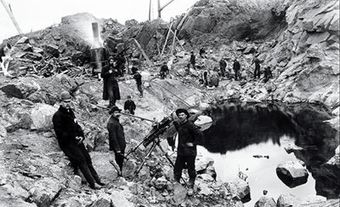Nomenclature
Two contrasting tendencies can be seen in mineralogical nomenclature. First, there are the names that convey useful information about the mineral itself and are based on the chemical composition, crystal form, colour, lustre or other properties. For example, caysichite, found near Poltimore, Qué, is named after its chemical composition (Ca, Y, Si, C, H). Secondly, there are minerals with names that communicate very little or no information about the composition or properties of the mineral. Such is the case when names of persons are used: some refer to the discoverer or first analyst of the mineral; others recall a famous person or a scientific institution. For example, weloganite is named after Sir William Edward Logan, the first director of the Geological Survey of Canada. Moreover, there are names of minerals that convey information about the region where they have been found. Some are quite specific about the location - eg, sudburyite named for Sudbury, Ont; others refer to a much larger area - eg, yukonite. The suffix ‘ite’ comes from the Greek meaning ‘derived from’. While the vast majority of mineral names end in ‘ite,’ some have the suffixes ‘ine’ or ‘ide.
Some 200-300 new minerals discovered, analysed or identified by Canadians have been enshrined in the international nomenclature with Canadian names. Two branches of the Department of Energy, Mines and Resources, the Geological Survey of Canada and the Canada Centre for Mineral and Energy Technology, rank very high among the leading institutions that identify and publish scientific studies on new minerals; at this time, they have at least half a dozen new species under examination.
A number of Canadian localities, regions and other geographical features are identified by names from the mineral kingdom. A famous example is Cap-Diamant. While investigating the surroundings of the native settlement of Stadacona (near Québec City), Jacques Cartier and his men noticed some sparkling, crystallized minerals attached to the rocks of the nearby cliff, which any modern geologist would describe as a formation of argillaceous limestones and bituminous schists dating back to the Middle Ordovician period (over 458 million years old). This formation forms part of the front of the Appalachians.
Cap Diamant
Understandably, these hexagonal crystals provoked great interest among Cartier's sailors, particularly those specimens showing a range of colours caused by the presence of minute quantities of bitumen. Samples of the newly found "diamonds" were brought back to France, where an informed mineralogist instructed Cartier and his men about the great difference between rock crystal and the most precious stone known to man (see Diamonds of Canada). It is probably this incident that is responsible for an old French saying, still heard in some parts of Normandy and Brittany: "Faux comme un diamant du Canada" [As false as a Canadian diamond]. Samuel de Champlain, founder of Québec (1608), made the same discovery some 70 years later, and the promontory was, accordingly, named Cap Diamant.
Many more Canadian geographical names have been derived from minerals. Dozens of lakes, creeks, points, inlets, hills and islands have names such as agate, amethyst, calcite, copper, emerald, garnet, gold, jasper, quartz, ruby, silver, sulphide, topaz and zircon, to name just a few of the minerals and precious and semiprecious stones currently used for this purpose across the country.

 Share on Facebook
Share on Facebook Share on X
Share on X Share by Email
Share by Email Share on Google Classroom
Share on Google Classroom

